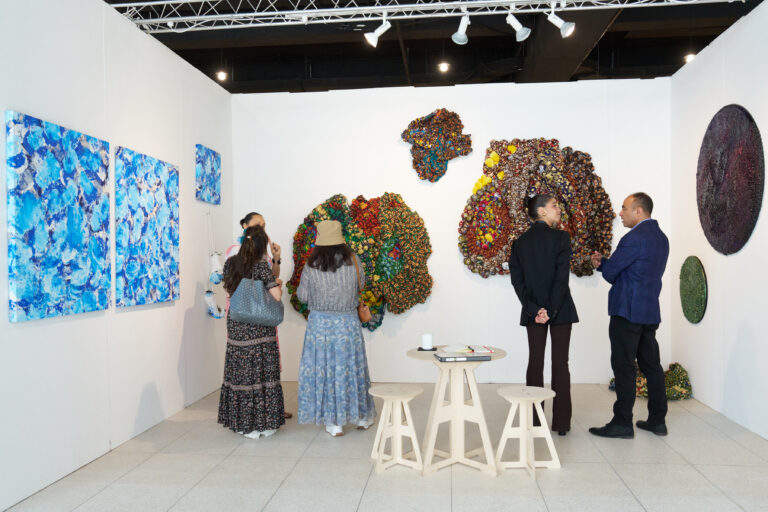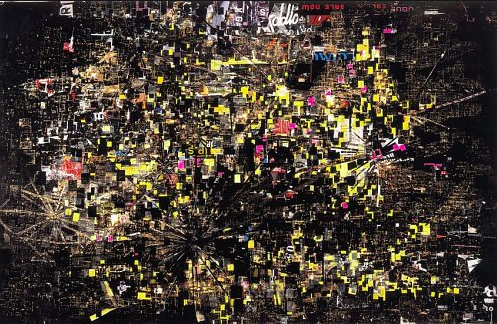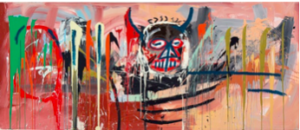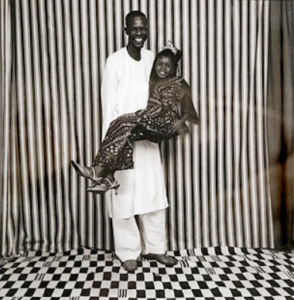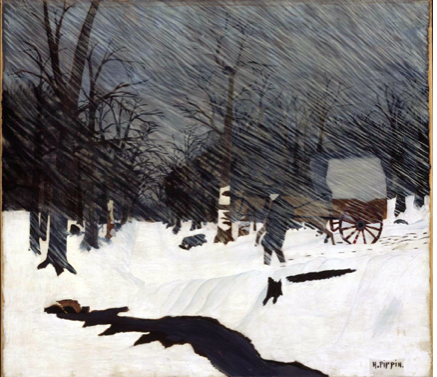The bodacious move to place a small sampling of artworks by African American artists in the White House’s Presidential Art Collection is having a ripple effect.
When President Barack Hussein Obama, and wife Michelle, (always a trend setter) decided to promote historic and classic African American artists like Alma Thomas, William H. Johnson and Henry O. Tanner, it was a strategic gesture. Although the perpetually stagnant contemporary art market constantly requires a few sprinkles of three or four “star” black artists to add flavor and authenticity; no one imagined an avalanche of interest in the works of African American artists would ensue. “Could this be the change in which we can believe” ?
Well, maybe. And yes, we came ready with the goody-good stuff! Modern, and Contemporary works by Black artists (The featured for this post is by Mark Bradford) are entering the conversation around American art where it really matters-the international art market. Auction galleries sales records are being established for Norman Lewis, Gordon Parks , Sam Gilliam, Mark Bradford -and of course- Jean Michel Basquiat. Next month the Roving Buffalo will examine in more detail this evolving trend.
Of note: the above painting by Basquiat will be auctioned next month at Christies Fine Art Auction in New York in excess of $40 million. It is a work completed in 1982 and measures morethan Ft 16 in width. With it’s multilayering of exquisite color and sheer burst of energy, this painting has everything we appreciate about Jean Michel’s work. Except the price tag.
Cinematography is another area where artists of color are beginning to challenge the existing narrative. The American film industry is sometimes a cliche where for black people the minstrel context continues to be the norm. Toni Morrison in her 1992 essay, Playing in the Dark: Whiteness and the Literary Imagination pretty much says it all. Read it. In the meantime, please reexamine the world as it exists right there in front of your screen.
On the positive tip is the excellence of actor Nate Parker. Aside from scripting, directing and acting in the soon to be released “Birth of a Nation” Mr. Parker will initiate the Nate Parker School of Film and Drama, at the historic Wiley College located on the West side of Marshall, Texas. Do yourself a favor and hit the link for a quick Sundance interview by the artist discussing how he came to create the story of Nat Turner for film.
We have been roaming and roving and waiting for four years to experience this movie. Miles Ahead written, directed and produced by Don Cheadle was released nationally on April 1, 2016.
Regardless of what one believes or cannot conceive; anthropology and just plain common sense assures us that Africa is the Mother of Everything. On Saturday, April 14, 2016, the Motherland lost a brilliant artist and imaginative child. Malick Sidibe was born in Soloba, Mali in 1936. A visionary artist at age 22, he began to photograph the world around him. Sidibe followed an impulse to document the transformation of Malin culture. At that time, it was a world in transition from the colonial to the post-colonial; becoming a homeland free of Eurocentric restrictions, cultural mis-interpretations and a place of expanding opportunities in all fields.
Sidibe’s straightforward photography contains an automatic quality, capturing the energy of fully realized lives and confirms photography as an artistic medium at service to humanity. In 2007 was Malick Sidibe was awarded the Venice Biennale art exhibition’s Golden Lion Award for Lifetime Achievement. He was the first photographer and the first African to ever receive the honor.
Five on the Black….
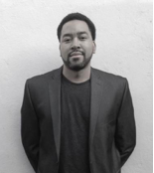 Hernan Guerrero, Associate, is an Urbanist with Dover, Kohl & Partners. He has an academic background in Geography (Clark University), Urban Planning (Pratt Institute) and Architecture (FIU). Hernan started his career developing Geographic Information Systems for cities, towns and counties throughout the Northeast, before receiving his Master’s in City and Regional Planning from Pratt Institute and working on projects ranging from neighborhood and comprehensive plans for local government, to developing affordable housing for a Community Development Corporation and serving as Main Street Program Coordinator for a Business Improvement District. The worsening housing crisis has put a strain on government housing programs which has led to companies, like the property block, taking on the task themselves to create houses for those on a lower income. However, it is still important that local communities have a say on projects in their neighborhoods.
Hernan Guerrero, Associate, is an Urbanist with Dover, Kohl & Partners. He has an academic background in Geography (Clark University), Urban Planning (Pratt Institute) and Architecture (FIU). Hernan started his career developing Geographic Information Systems for cities, towns and counties throughout the Northeast, before receiving his Master’s in City and Regional Planning from Pratt Institute and working on projects ranging from neighborhood and comprehensive plans for local government, to developing affordable housing for a Community Development Corporation and serving as Main Street Program Coordinator for a Business Improvement District. The worsening housing crisis has put a strain on government housing programs which has led to companies, like the property block, taking on the task themselves to create houses for those on a lower income. However, it is still important that local communities have a say on projects in their neighborhoods.
Hernan has a diverse multi-cultural background that has driven him to always seek out new information and knowledge. He was born in Panama, and grew up in New York and Geneva, Switzerland. At an early age he began to question why development was so different from country to country or neighborhood to neighborhood. He credits a love of Hip Hop and skateboarding with furthering his interests in spatial analysis and community redevelopment. His hobbies include photography, cooking, traveling and DJing.
RB1. Why did you choose to live in the historic West Grove neighborhood in Miami?
HGThe West Grove is a neighborhood with a lot of history. We needed to find more space for our kids and were lucky enough to find a Bahamian style wood frame house built in 1925. It reminded me a lot of the houses built by West Indians in Panama, where I am from originally. It has been my best experience so far living in Miami as I have gotten to meet a lot of my neighbors in the last 3 months. In the 5 years we spent at our previous address hardly anybody said hello.
2. Your background is multi-layered in the areas of Geography, Regional Planning and Architecture. Why?
I was fortunate to travel a lot growing up in Panama, New York and Geneva, Switzerland. I was very much in to the arts in high school, but in my junior year I had an amazing Geography teacher. Cultural, political geography, demographics and spatial analysis were some of the topics we investigated and it inspired me to study that in college instead of art. After working for a couple of years with Geographic Information Systems, I decided to study City & Regional Planning, because I knew I wanted to do work in community development. I went to Pratt Institute in Brooklyn where I learned about public participation and advocacy planning. I wound up working for a community development corporation in Brooklyn developing affordable housing just before the 2007/08 economic downturn. Later I worked for a Business Improvement District and for a municipality developing a comprehensive plan. I finally decided to go back to school for architecture, as my creative side kicked back in and I realized I wanted to be more on the design end of things. I moved down to Miami and studied architecture at FIU. I now work as a town planner at Dover, Kohl & Partners, a planning and urban design firm in Coral Gables.
3. What music are you playing?
I just joined Apple Music, so I have been brushing up on my musical favorites including Steel Pulse, Jamiroquai, John Coltrane, Gangstarr, Talib Kweli. As far as new music, I have been listening to the Anderson Paak Malibu album.
4. Why is a collaboration with visual artists in conceiving and implementing your personal vision important ?
Music and visual arts have been critical parts of my life. I grew up in New York in the 80s, when subways were plastered with graffiti. I think the stimulation that people get from music and art are a critical part of our daily lives. That stimulation enables you to break away from your daily routine and inspire you to think differently, to be creative. Without visual artists reinventing how we see and understand things life would be very boring.
5. What has been the most surprising experience you and your wife have had raising 2 kids?
We have a seven year old daughter and a nine-month-old baby boy. Having them so far a part has been interesting. It’s almost like going back to the drawing board, but also enables us to see how much our daughter has grown. It is amazing to see yourself in your children; I feel I wind up learning from them about myself and that pushes me to continue to learn and grow.
